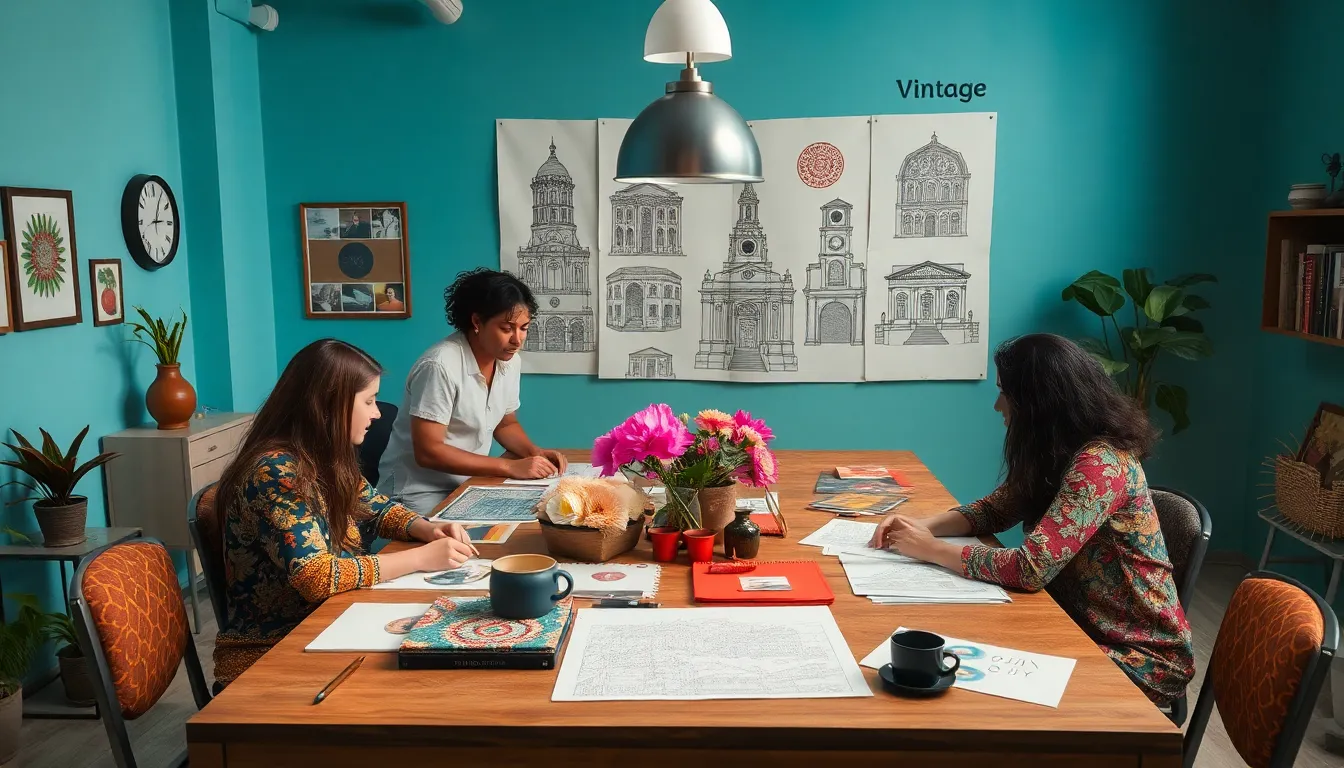Table of Contents
ToggleCulture and design are like peanut butter and jelly—separate, they’re good, but together, they create something truly delicious. From the vibrant colors of traditional textiles to the sleek lines of modern architecture, culture shapes design in ways that can make or break a project. It’s not just about aesthetics; it’s about telling a story, evoking emotions, and connecting people.
Imagine walking into a space that feels like a warm hug or flipping through a magazine that sparks joy. That’s the magic of blending culture and design. As global influences collide, designers have an incredible opportunity to create environments that resonate on a deeper level. So, whether you’re an aspiring designer or a curious culture enthusiast, buckle up! This exploration of culture and design is bound to inspire and maybe even tickle your funny bone along the way.
Overview of Culture and Design
Culture and design intertwine to create meaningful environments that resonate with individuals and communities. Each element contributes uniquely to shaping experiences. Design not only encompasses visual aesthetics but also serves as a medium for cultural expression. Through thoughtful design choices, cultural narratives come to life, fostering emotional connections among people.
Cultural influences impact design in various ways, including tradition, rituals, and values. These influences guide the selection of colors, materials, and shapes in any project. For example, a space designed in a contemporary style might incorporate local motifs that reflect historical significance. Designers can engage with communities to highlight regional characteristics, enhancing the authenticity of their work.
Community engagement fosters collaboration and deep understanding. Designers must listen to community voices, ensuring that spaces reflect their users’ identities. Spaces that celebrate local heritage cultivate a sense of pride and facilitate connections among residents. Personal stories and collective history influence design, creating environments that invite interaction.
Additionally, cultural sensitivity plays a crucial role in design decisions. Incorporating diverse perspectives ensures representation and minimizes cultural appropriation. Striking a balance between innovation and tradition fosters inclusivity while respecting cultural backgrounds.
Recognizing the link between culture and design enhances environments, making them more engaging and meaningful. Each project becomes a canvas for storytelling, where design elements act as visual languages that communicate cultural values. This symbiotic relationship shapes not only the physical world but also the emotional landscape of communities.
The Influence of Culture on Design

Culture significantly shapes design, impacting aesthetics, functionality, and emotional resonance. By understanding cultural contexts, designers create spaces that reflect values and beliefs, making environments more relatable.
Historical Perspectives
Historically, design elements often mirrored cultural narratives. Ancient civilizations, such as the Egyptians, incorporated hieroglyphs and symbolic colors into their architecture. In medieval Europe, Gothic cathedrals displayed intricate designs that conveyed religious stories. Indigenous cultures utilized local materials and traditional techniques, illustrating a deep connection to their environment. These examples highlight how historical influences shaped identity through design, reinforcing community ties and cultural legacies.
Contemporary Examples
Contemporary design draws inspiration from various cultures. Scandinavian minimalism embraces simplicity while paying homage to nature, reflecting Nordic values of functionality and sustainability. In contrast, Moroccan design showcases vibrant patterns and textiles, telling stories of rich traditions. Urban spaces increasingly incorporate local art to celebrate cultural diversity, enhancing community engagement. By integrating these cultural elements, designers create impactful experiences that resonate with users on multiple levels, fostering connections and enriching environments.
Design that Shapes Culture
Design serves as a powerful medium that shapes culture, influencing perceptions and human experiences. Various forms of design play crucial roles in reflecting cultural narratives and fostering connections among individuals.
Architecture and Urban Design
Architecture defines spaces that reflect cultural identities. Designers often incorporate local materials and traditional techniques, honoring historical contexts and community values. Urban design focuses on creating environments that enhance social interactions. Streetscapes encourage gatherings, while parks promote recreational activities, inviting cultural celebration. Specific examples show how cities like Barcelona use architectural features to tell stories of their heritage. Such designs elevate the experience of residents and visitors alike, bridging the gap between culture and functional living spaces.
Graphic Design and Visual Identity
Graphic design communicates cultural messages through visuals. Designers utilize elements like color palettes, typography, and imagery to convey brand values. For instance, a vibrant color scheme may reflect a community’s lively spirit, while minimalist design can suggest sophistication. Visual identity connects businesses to their cultural context, making branding relatable. Many firms have successfully integrated cultural symbols into their graphics, reinforcing brand loyalty and fostering emotional connections. Effective graphic design not only enhances visual appeal but also deepens the cultural resonance of a brand’s message.
Global Perspectives on Culture and Design
Culture and design are closely intertwined, with each shaping the other across different regions. Global perspectives reveal that diverse cultural backgrounds influence design practices in unique ways.
East vs. West Approaches
Eastern and Western approaches to design reflect differing cultural values. Eastern design often emphasizes harmony, balance, and nature, drawing inspiration from traditions and spirituality. Elements like natural materials and fluid forms create serene environments. In contrast, Western design tends to prioritize innovation, functionality, and individuality. Minimalist aesthetics, clean lines, and industrial materials dominate modern Western spaces. Each approach captures its geographical culture’s essence, demonstrating the impact of beliefs and history on design.
Cultural Exchange in Design
Cultural exchange enriches design practices globally. Designers frequently borrow elements from various traditions, blending styles to create innovative works. Collaborative projects highlight this exchange, where artists combine techniques and materials from different cultures. Urban environments showcase this fusion, with buildings reflecting a mix of influences that celebrate diversity. For instance, global cities often feature architecture that melds local styles with international trends. These interactions foster mutual respect and understanding, ultimately enhancing community ties while showcasing the beauty of cultural diversity in design.
The interplay between culture and design is a dynamic force that shapes our environments and experiences. By embracing cultural narratives and values, designers can create spaces that resonate deeply with individuals and communities. This connection not only enhances functionality but also fosters emotional ties that enrich daily life.
Recognizing the significance of cultural sensitivity and diverse perspectives is vital for creating authentic designs. As designers continue to draw inspiration from a variety of cultural influences, they contribute to a richer tapestry of experiences that celebrate heritage and promote understanding. Ultimately, the fusion of culture and design invites everyone to engage with their surroundings in meaningful ways.




